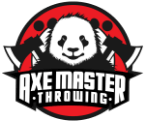Axe-Throwing Equipment: Gear Up for a Thrilling Axe-Throwing Session
Activities channeling your inner warrior are few, especially if you don’t have the time, patience, or access to vast wooded areas for pastimes like bow hunting. That’s what makes axe throwing so compelling. You can put on a T-shirt, jeans, and a pair of close-toed shoes, do some shopping, catch a movie, and then become a Viking for a couple of hours while you hurl axes at targets. Afterward, you can pack up your axes and resume your daily routine.
If this sounds awesome, you might wonder, “What axe-throwing equipment do I need?” Great question! Getting the right throwing axes equipment for beginners will make it a fun and safe endeavor.
Axe Throwing Equipment: 7 Essentials
If you’re going to enjoy some recreational axe-throwing games at Axe Master, your session will include all the axe-throwing equipment necessary. Still, whether you plan on purchasing the supplies and accessories or using what’s provided, you should be familiar with the regulation equipment for axe-throwing.
1. Axes
If you’ve ever been to a gun range, you know many firearms are available in a wide array of cartridge types. It’s similar to throwing axes, which come in different shapes and sizes. There’s so much variation because each axe has its own throwing characteristics, some of which make them more suited for beginners vs. pros.
As for the different types of throwing axes, there are:
Hatchets
These are the most common types of throwing axe. Originally used for cutting through brush in forests, these are relatively small at about a foot long and only weigh a few pounds. There’s only one blade, which must be four inches or less. Hatchets are perfect for beginners thanks to their balance and easy throw-ability.
Tomahawks
This type of axe descends from the kind invented by Native American tribes, though modern versions are significantly different. Modern tomahawks use metal blades, for example. While tomahawks are about the same size as hatchets, they’re much lighter and feature straight handles. This quality makes them accurate for experienced throwers but can be difficult for beginners.
Double-Bit Axes
With two blades on either side of the head, this is the throwing axe you’ll want to use to feel like a Viking or a lumberjack! With the two edges, throwers double their chance of getting the axe to stick in a target.
Felling Axes
When someone pictures an axe, they’re most likely thinking about splitting axes. These are used for chopping down trees and have long handles offering lots of leverage. Blades are thin and sharp. This type of axe is definitely more for experienced throwers.
2. Backpacks and Sheaths
A good backpack is one of the most essential axe-throwing equipment accessories. It protects your axes from exposure to harmful environmental elements that can lead to rusting heads or rotting handles. Some backpacks are designed to cover an entire axe, while others allow the axe to stick out slightly for quick access.
You should always keep your axes in a sheath, even in the backpack. The sheath is there to preserve axe sharpness and prevent you from getting cut! Sheaths are usually made of leather or plastic.
3. Clothing
While considering axe-throwing equipment supplies, you don’t necessarily need specific clothes. What you must have are close-toed shoes or boots. If you drop an axe, you want protection for your feet! Once you have the footwear covered, you’ll just need a T-shirt and a pair of pants. They should be comfortable and allow for free, easy movement while throwing.
4. PPE (Personal Protective Equipment)
After throwing for a while, your hands can get blistered. Chalk can provide excellent grip without tearing skin, but many axe throwers rely on gloves. You should get gloves from axe-throwing equipment suppliers to ensure they have the right level of grip for the sport. The next piece of PPE you might want is a set of goggles. While not strictly necessary, having protective equipment to prevent splinters from axe throwing is always a good idea.
5. Targets
Axe-throwing targets are almost always made of wood, so the axes stick into them. Sometimes targets are made from other materials to avoid splinters. Competition-minded throwers often set up small throwing equipment axe boards to hone their aim. However, targets at competitions or axe-throwing businesses will be regulation height and size.
Regulation targets in the International Axe Throwing Federation (IATF) must be six inches wide and 10 inches tall. The center of the seven-inch bullseye must be 63 inches from the ground. Two rings surround the bullseye, and there must be two two-inch rings called clutches.
World Axe Throwing League (WATL) targets must have 36 inches from the floor to the bottom of the footer. The 48 x 48-inch targets have five rings that surround the bullseye, and the clutches (called Killshots in the WATL) are inside the outermost ring.
6. Scoreboard
Want to know whether you’re winning or not? You’ll need an axe-throwing equipment scoreboard.
In the IATF:
- Bullseyes are five points
- The inner circle is three points
- The outer ring is one point
- The clutches are seven points
In the WATL:
- Bullseyes are six points
- Ring 1 is five points
- Ring 2 is four points
- Ring 3 is three points
- Ring 4 is two points
- Ring 5 is one point
- The Killshots are eight points
Typically, throwing axe ranges have scoreboards on hand.
7. Axe Sharpener
Finally, remember to maintain your axes with a quality sharpener. You’ll want an axe sharpener in your arsenal to bring dull axes back to life after a long target practice session. You can use stone, file, electric, and even standard knife sharpeners.
Gear Up and Start Throwing at Axe Master
Now you are familiar with seven essential types of throwing axe equipment. If you still need help finding the necessary equipment and accessories, Axe Master is an excellent resource. Experienced axe masters provide training before every session and are happy to talk to you about what gear is best for you and where to find it. Book your axe-throwing session at Axe Master and find out just how addicting axe-throwing can be!

